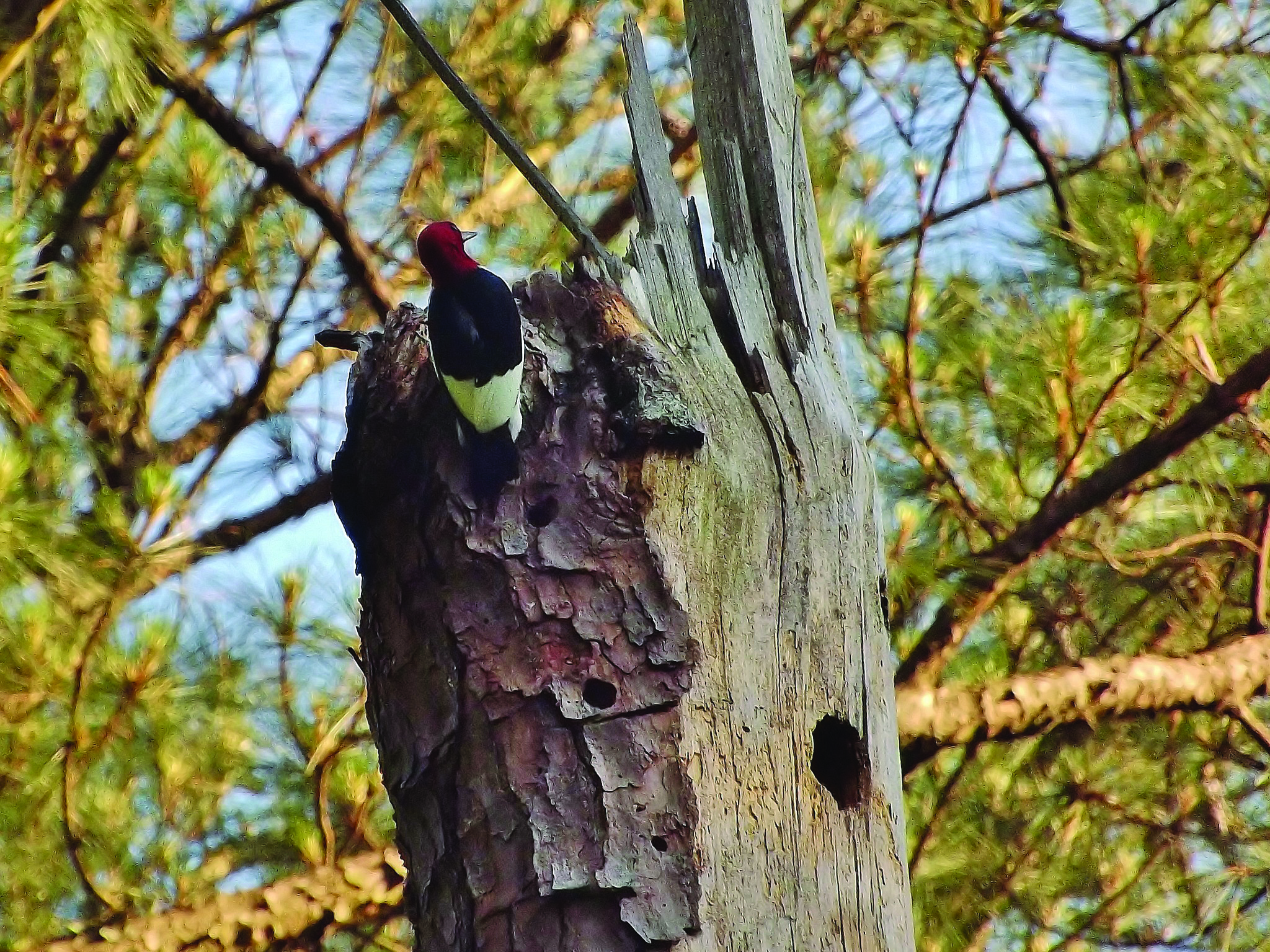One sure sign that spring is coming is the distinct drumming sound that woodpeckers make when they rap-a-tap-tap on trees. They make music on standing dead tree snags and are one of very few animals that can make a sound using something other than just their own body parts. They drum on a variety of objects (sometimes even houses) to communicate territory, attract mates, locate food (usually insects), and maybe even for exercise or play.
The patterns and rhythms of drumming help to identify woodpeckers, of which we have a great variety in Wake County. Our mixed deciduous hardwood forests and wetlands make good habitat for woodpeckers, which come in many shapes and sizes from the largest—the Pileated Woodpecker, at almost 20 inches in length and with a wingspan of 30 inches—to the smallest—the Downy Woodpecker, which is usually around six inches in size with a wingspan of about 10 inches.
One of the most distinct woodpeckers we are fortunate to see sometimes in the state and even in the town of Apex is the boldly patterned Red-headed Woodpecker, with an entirely crimson head, a snow-white body, and half white, half black wings. Called the “flying checkerboard” by the Cornell Lab’s “All About Birds” webpage, these medium-size woodpeckers are usually around 7-9 inches in length and have a wingspan of about 16.5 inches. Unfortunately, they have experienced more than a 70% decline in population size since 1966 due to habitat loss, changes in their food supply, and nesting competition by other birds like European Starlings.
Red-headed Woodpeckers move around seasonally and fiercely defend their territories. For nesting sites, tree cavities with perfectly round holes are excavated and 4-7 white eggs are laid inside. They nest in dead trees or dead parts of live trees—including pines, maples, birches, cottonwoods, and oaks—in fields or open forests with little vegetation on the ground. They often use snags that have lost most of their bark, creating a smooth surface that hopefully deters snakes, which eat their eggs and nestlings. They have also been known to excavate holes in live branches, utility poles, or buildings. Unlike many woodpeckers, they often reuse a nest cavity several years in a row.
These woodpeckers are known to catch insects in the air, and they eat lots of acorns and beech nuts, and even fruit. Often they will hide away extra food in tree crevices and seal up their cache with wet splinters that dry out to form a tight cover! They are one of only four North American woodpeckers that store food, and the only one that covers stored food with wood or bark. According to the Cornell website, they “hide insects and seeds in cracks in wood, under bark, in fence posts, and under roof shingles.” Grasshoppers are stored alive but wedged into crevices so tightly that they cannot escape!
Red-headed Woodpeckers have been observed at the Apex Community Park for many years, although sightings are not common. This park is a good place to see many woodpeckers, especially in the swampy area located halfway around the lake trail. Typical sightings include Red-bellied Woodpeckers (sometimes mistaken as the Red-headed variety), Downy Woodpeckers, and Yellow-bellied Sapsuckers, and other woodland birds such as the White-breasted and Brown-headed Nuthatches. Pileated Woodpeckers have also been spotted.
Apex Community Park is known as a birding hotspot and sighting records are available online: https://ebird.org/hotspot/L496866. Eleven observations of Red-headed Woodpeckers are included, the last taking place on October 9, 2021 (acorn season). A total of 139 bird species have been observed in the park, including eight kinds of woodpeckers.
On a recent walk at Apex Community Park, a number of Red-bellied Woodpeckers were observed searching for nesting sites and heard drumming on trees, while Downy Woodpeckers and Yellow-bellied Sapsuckers were seen searching tree branches for insect snacks, and Brown-headed Nuthatches were busy excavating tree cavities in preparation for the upcoming nesting season. Chickadees and nuthatches don’t have the powerhouse drilling bills of woodpeckers. But these little birds do drill their own nest cavities in the rotten wood of old trees.
Fun fact: Woodpeckers like to stay upright. They keep their heads upright while other insect-eating tree species of birds such as nuthatches crawl down trees headfirst. These birds access trees in different ways, thereby reducing competition between the species.
While Red-headed Woodpeckers are not a common species in Wake County, local bird lovers have had luck in seeing them along parts of the White Oak Creek Greenway and the Beaver Creek wetland on the American Tobacco Trail. Other people reported having seen them at Lake Betz, Historic Yates Mill County Park, Shelly Lake, Hilltop-Needmore Park, and near flooded timber at Falls Lake and Jordan Lake.
As already mentioned, most woodpeckers make new nesting cavities every year, while their old nests are utilized by other wildlife such as bluebirds, swifts, owls, ducks, and bats, depending on the size of the nest hole. The cavities hollowed out by the birds vary in size, depending on the species. The chamber of a Downy Woodpecker descends about a foot from the opening, while the Pileated Woodpecker may chip out a chamber two feet deep. Both are beyond the reach of a pesky raccoon, another potential predator of eggs and chicks.
“A woodpecker’s drilling Echoes to the mountain clouds.” ~Dakotsu lida
Woodpeckers have several features that help them adapt to a wood-drilling lifestyle. Their bills help to distribute the shock throughout the thick skull when pecking and they have feathers in their nostrils which help to keep out wood splinters and dust. They also have strong tail feathers that support them well against tree trunks, two back toes to lean on, and they have super long sticky tongues, too, for catching insects. When not in use, their tongues curl around the back of their heads, between the skull and the skin!
The special skills and unique lifestyles of our feathered friends are a sight to behold, and the sounds of woodpeckers drumming, making new nests, and calling to one another from the tall trees can be taken as encouraging signs that spring is on the way and nature’s seasonal cycles continue. Watching the determination, resiliency, and hard work of the woodpeckers can also be awe-inspiring. We encourage you to get out and about in Apex to see some of these natural wonders for yourself.
To learn more about Red-headed Woodpeckers, check out the Wake Audubon Society’s Bird of the Year (2020) webpage: https://www.wakeaudubon.org/bird-of-the-year-2020/, and the Carolina Birding Club’s online species profile: http://ncbirds.carolinabirdclub.org/view.php?species_id=354.








